Guide to Abiotic Disorders of Woody Plants in the Landscape
Plants are often subjected to stresses in the environment that are not the result of insects or diseases but of human activities. These stresses are referred to as “abiotic” diseases. These abiotic disorders result in the plant being less vigorous and, in many cases, dying.
Abiotic problems often involve multiple factors. A plant’s response to these factors can be subtle in nature and accumulate over time, making them difficult to diagnose. It can be even harder explaining to a homeowner how they harmed their plant by something they did years ago.
Typical stress symptoms of abiotic problems include very slow growth, poor foliage color, leaf scorching, presence of lichen, limb dieback, or plant death. This publication presents a discussion of some of the more common abiotic problems that occur in the landscape.
Planting Too Deep
The number-one problem associated with abiotic tree disorders is planting too deep. Many trees and shrubs are set too deep in the hole/ground at the time of planting, or they settle over time. A planting depth of only 1 inch too deep can cause future problems (Figure 1). It is not uncommon to see trees planted as much as 3 or more inches too deep. If a tree resembles a telephone pole going into the ground, then it is planted too deep.
Various symptoms point to excessively deep planting. Dieback of branch tips can occur during the stress of summer. Advanced symptoms of depth-related stress are cankers and deep cracking of the bark.
Remedy: This problem is easily prevented by making sure the root flare on a tree is at soil grade or slightly above when planted. Removing soil to lower the grade generally does not help unless the tree is newly planted.

Mechanical Damage to Trunk
Mechanical damage opens up trees and shrubs to disease organisms. Damage can come from vehicles, string trimmers (aka “weed-eater disease”; Figure 2), lawn mowers, construction equipment, garden tools, animals, or other human activities. String-trimmer injury is particularly bad on trees and shrubs with thin bark. Repeated bumping into the same area of a trunk without cutting the bark can also damage or kill the growing point under the bark, resulting in reduced growth.
Remedy: Creating a machine-free zone around trees and shrubs with mulch can greatly reduce mechanical injury. A properly applied mulch ring will keep equipment away from the trunk. You can also use trunk guards to protect trees.

Improper Mulching
Mulch is used around plants to help conserve soil moisture, moderate soil temperatures, reduce weeds, and keep equipment away from plant trunks. The recommended depth is 2 to 3 inches for most organic mulches. Many gardeners, believing that more is better, create “mulch volcanoes” (Figure 3). When mulch is piled up against the tree trunks, the bark stays too wet. Decay can occur, and the entire plant may die.
Remedy: Keep mulch several inches away from the trunk. As the old mulch decomposes, it can be removed and worked into other garden areas. Additional mulch may be added occasionally to supplement the existing covering.
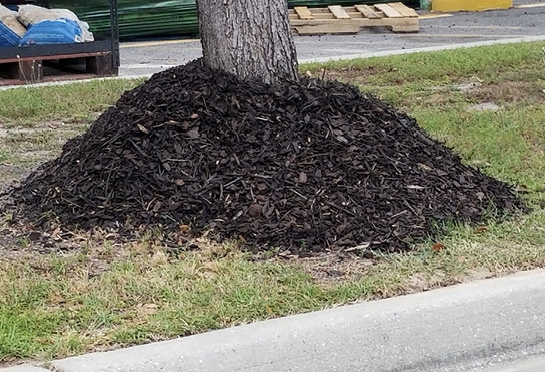
Girdling Roots
A girdling root is one that is circled around the trunk or other roots at or below the soil line (Figure 4). It gradually cuts off the flow of nutrients. Maples, elms, and birches are particularly prone to their formation. Container-grown trees and shrubs that are often pot-bound frequently develop girdling roots. It is important to spread or cut circling roots at planting time to prevent future strangulation issues.
Remedy: Plant nursery stock that does not have circling roots in the pot. Dig a planting hole two to three times wider than the root ball. Girdling roots take years to develop. Early detection is important. Crossing roots that are visible on the soil surface and cutting into a tree trunk should be cut and removed while they are small.
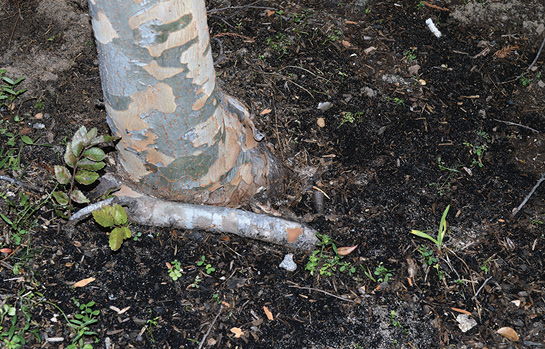
Soil Compaction
Soil compaction is a major problem after construction. Its effects last for years. When the soil is compressed by trucks, cars, excessive pedestrian traffic, construction material, or heavy construction equipment, the soil structure is damaged (Figure 5).
Air space in the soil is reduced or eliminated, depriving roots of oxygen. Wet soil and soil with a high clay content compact quickly. Soil compaction is a slow process that causes poor growth and even death of mature, well-established woody plants.
Remedy: Keep construction equipment and building materials outside the drip line of trees. Compacted soils in a planting bed can be improved by tilling in liberal amounts of organic matter before planting. Do not add it directly to the planting hole because it will cause water to collect in the hole after planting. Compacted lawn areas can be revived by going over the affected area with a lawn aerator.
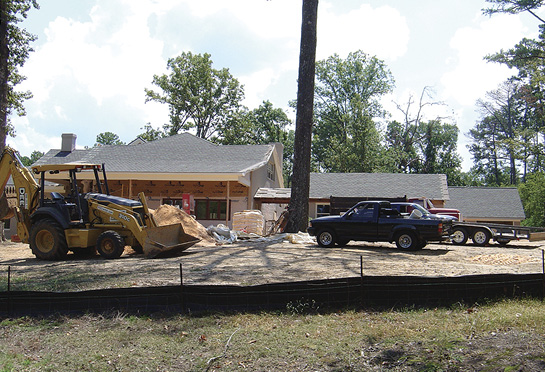
Mechanical Root Damage
Construction damage impacts trees and shrubs in numerous ways: compacted soil, grade changes, loss of leaf area, and severe root loss or injury. It usually sets the tree up for gradual decline or death over a period of several years. Anytime the soil grade is lowered or raised, even a few inches, existing shrubs and trees become predisposed to other environmental stresses.
Most of the feeder roots of trees or shrubs are within the upper 6 inches of the soil. Any digging, trenching, or rototilling within the root area of established trees or shrubs will cause harm (Figure 6). Damage usually occurs when establishing a new flower bed, adding shrubs under trees, installing a sprinkler system, or paving a driveway or patio area. The degree of damage depends on the depth of the digging and the amount of ground covered. Root damage may haunt the plant months or even years later, depending on the later environmental stresses.
Remedy: There is very little that can be done for roots damaged by digging. A minor amount of damage may have no visible effect, but severe damage will cause branch dieback. The best help for root-damaged trees or shrubs is to prevent any additional stress. Keep them watered during droughts and provide a light fertilization in the spring to stimulate new growth.
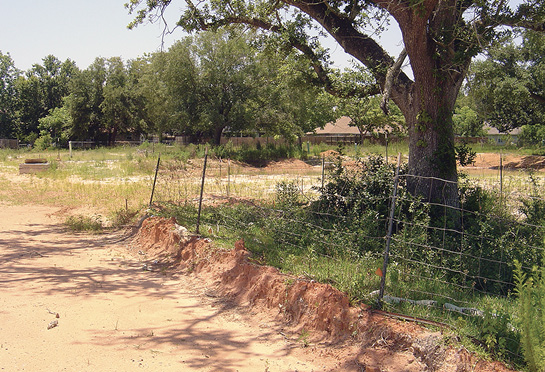
Herbicide Damage
Symptoms of herbicide damage will vary according to the type of chemical involved. The problem is usually associated with the misuse or drift of broadleaf weed killers applied to turfgrass (Figure 7). Dicamba, 2,4-D, imazaquin, and glyphosate herbicides are usually responsible for the damage. Symptoms include elongated stem growth, dieback of branches, prominent veins, leaves turning white, and curling or cupping leaves. Herbicide damage can eventually cause death of the plant.
Remedy: Only apply herbicides labeled for use around the plants in your landscape. Often the damage is outgrown, and the plant recovers. If a plant was accidently sprayed by an herbicide, immediately washing of the foliage with water can reduce the damage.
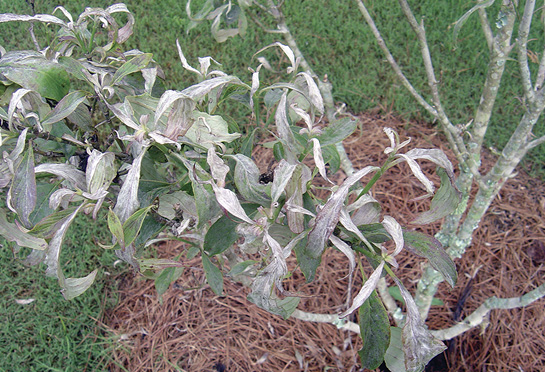
Packaging Material
Packaging and related material are often left on plants after planting. Nursery tags, wire baskets, twine, staking materials, and even containers are left on the plants and then forgotten (Figure 8). The material left on plants often becomes imbedded in the roots or trunk, reducing growth and causing a gradual decline in overall plant health. It may eventually kill the plant.
Remedy: Remove all packaging materials at the time of planting, especially wire baskets and nylon twine. Carefully remove packaging on ball and burlap plants after they have been placed in the planting hole.
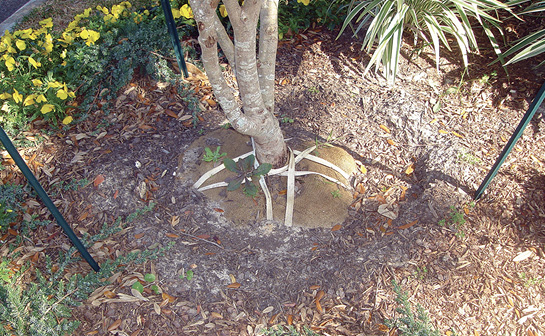
Over Watering/Poor Drainage
Excessive water application or poorly drained soils cause root-rot problems or feeder-root death due to low oxygen levels (Figure 9). These problems result in weak or stunted growth and often death of the plant. They can mimic the symptoms drought-stress.
Remedy: Reduce irrigation timing and water deeply and infrequently. Improve internal soil drainage by adding organic matter. Plant in raised beds. Divert excess surface water. Use the right plant for the planting site.
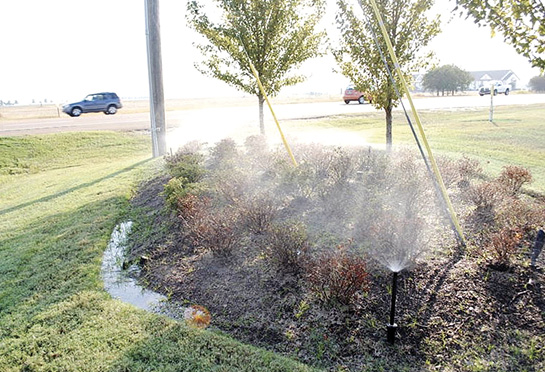
Summary
Humans can unknowingly inflict stresses on trees and shrubs in the landscape. It is amazing how forgiving plants can be, considering all the pressures we put on them. Further education about good landscape maintenance practices can reduce these disorders.
The information given here is for educational purposes only. References to commercial products, trade names, or suppliers are made with the understanding that no endorsement is implied and that no discrimination against other products or suppliers is intended.
Publication 3174 (POD-10-23)
Revised by Jeff Wilson, PhD, Assistant Horticulture Professor, North Mississippi Research and Extension Center, from the original by Wayne C. Porter, PhD, Regional Extension Coordinator (retired).
The Mississippi State University Extension Service is working to ensure all web content is accessible to all users. If you need assistance accessing any of our content, please email the webteam or call 662-325-2262.




